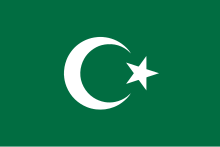
Back مسلمون (جنسية) Arabic Мюсюлмани (народ) Bulgarian Muslimani (narod) BS Musulmans (nacionalitat) Catalan Muslimani Czech Μουσουλμάνοι (εθνότητα) Greek Jugoslavaj islamanoj Esperanto Musulmanes (nacionalidad) Spanish Muslimid (etniline rühm) Estonian Musulman (nazionalitatea) Basque
Muslimani Муслимани | |
|---|---|
 Flag used to represent various Muslim minorities in the former Yugoslavia | |
| Total population | |
| c. 51,000 | |
| Regions with significant populations | |
| 13,011 (2022)[1] | |
| 12,101 (2013)[2] | |
| 10,467 (2002)[3] | |
| 10,162 (2023)[4] | |
| 3,902 (2021)[5] | |
| 1,187 (2021)[6] | |
| Languages | |
| Serbo-Croatian, Macedonian and Gora dialect | |
| Religion | |
| Sunni Islam | |
| Related ethnic groups | |
| Other mainly Muslim South Slavs | |
Muslims (Serbo-Croatian Latin and Slovene: Muslimani, Serbo-Croatian Cyrillic and Macedonian: Муслимани) is a designation for the ethnoreligious group of Serbo-Croatian-speaking Muslims of Slavic heritage, inhabiting mostly the territory of the former Socialist Federal Republic of Yugoslavia. The term, adopted in the 1971 Constitution of Yugoslavia, groups together several distinct South Slavic communities of Islamic ethnocultural tradition. Before 1993, a vast majority of present-day Bosniaks self-identified as ethnic Muslims, along with some smaller groups of different ethnicities, such as Gorani and Torbeši. This designation did not include Yugoslav non-Slavic Muslims, such as Albanians, Turks and some Romani people.[7]
After the breakup of Yugoslavia, a majority of the Slavic Muslims of Bosnia and Herzegovina adopted the Bosniak ethnic designation, and they are today constitutionally recognized as one of three constituent peoples of Bosnia and Herzegovina. Approximately 100,000 people across the rest of the former Yugoslavia consider themselves to be Slavic Muslims, mostly in Serbia. They are constitutionally recognized as a distinct ethnic minority in Montenegro.[8]
- ^ "2022 Serbian census" (PDF).
- ^ "Popis 2013 BiH". popis.gov.ba. Retrieved 19 August 2017.
- ^ verska, jezikovna in narodna sestava (2002) od statistični urad republike Slovenije
- ^ "Stanovništvo Crne Gore prema nacionalnoj odnosno etničkoj pripadnosti, vjeri, maternjem jeziku i jeziku kojim se uobičajeno govori" (PDF). Monstat.org. 15 October 2024. Retrieved 15 October 2024.
- ^ "Population by Ethnicity/Citizenship/Mother tongue/Religion" (xlsx). Census of Population, Households and Dwellings in 2021. Zagreb: Croatian Bureau of Statistics. 2022. Retrieved 8 April 2023.
- ^ "1. Census of Population, Households and Dwellings in the Republic of North Macedonia, 2021 - first dataset" (PDF). State Statistical Office of North Macedonia. Retrieved 17 November 2022.
- ^ Dimitrova 2001, pp. 94–108.
- ^ Đečević, Vuković-Ćalasan & Knežević 2017, pp. 137–157.